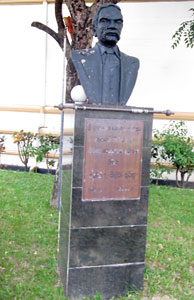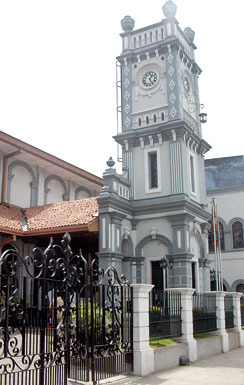Wanted – a proper home for Sinhala theatre
It was good to read that the John de Silva Memorial Theatre behind the Art Gallery is to get a facelift. It needed one badly. We did enjoy Sinhala theatre there for over two decades but there was something lacking. In fact, it was the preferred theatre for the annual Sinhala drama festival which in the years prior to its construction, was held at the Lumbini Hall, the school hall at Lumbini Maha Vidyalaya – Havelock Town which was upgraded in the mid-1950s when it was found that there wasn’t a venue to stage Sinhala dramas.
The John de Silva Theatre was built in 1987 to honour the great dramatist who wrote and produced several historical and religious plays in the early years of the 20th century. Dropping in there a few days back, I was told that it is closed for repairs although work has still not begun. Security staff keep a watchful eye. Behind I heard the sound of drums from the adjoining Institute of Aesthetic Studies campus.

The bust of John de Silva now in the garden
Looking back, although there have been a lot of talk about a well-equipped state sponsored theatre it has not really materialised. The recently opened Nelum Pokuna is meant for lavish productions and is not suitable for normal dramas.
To take a glimpse of the past, the first purpose-built theatre in Sri Lanka was the Tower Hall at Maradana which was opened in December 1911 at a time when dramas were staged at ‘belek halls’ or ‘takarang halls’ – so called because of the galvanised sheeting used on the roofs. There were several of these in the city – Pavilion Theatre at Maradana junction, the Public Hall at the Ibbanwela (Darley road) junction at Hunupitiya, Saraswathy Hall in Pettah and Madhuramnaambika Hall at Gintupitiya.
The Tower Hall had a seating capacity for 800 and 400 more could stand and watch plays from the two sides. There was also provision to screen films. Changing rooms for the players and make-up rooms were also provided. It was constructed by Hendrick Seneviratne, a businessman at Maradana.
The clock tower where the time can be read from three sides gave the hall its name. Said to have been erected on the lines of the Tower of London, it remains a landmark to this day.
With the death of the owner in December 1929, the management of the theatre faced problems and a huge flood which swept through the area in 1930 was the death knell of the Tower as far as staging plays was concerned. Later it was used as a cinema hall. Ceylon Theatres bought the hall from a private owner. It was taken over by the government on the initiative of Prime Minister R. Premadasa in March 1978. The Tower Hall Theatre Foundation was formed under an Act of Parliament and the hall was rebuilt. However, it did not become a popular place for theatre.
Meanwhile, the YMBA hall, in Borella became the popular venue for Sinhala plays and although the Lionel Wendt Theatre was opened in 1953, the Sinhala dramatists felt it was a “strange place” for them, at least until Professor Sarachchandra’s ‘Maname’ created a stir among the Wendt-goers. Though some were quite comfortable at the Wendt, many looked for other venues.

The Tower Hall: Standing tall through the ages. Pic by Nilan Maligaspe
The dramatists were quite at home at the Lumbini hall which soon came to be called the ‘Lumbini Theatre’. The audience was equally happy there. It became the centre of the resurgence of Sinhala theatre in the latter part of the 1950s and every weekend plays were staged there. It continued to be popular and with the John de Silva Theatre being closed for the past few months, Lumbini is once again quite active.
The Punchi Theatre at Borella is being used regularly even though space is rather limited. Yet, in today’s context when Sinhala plays don’t enjoy the same popularity like the Henry Jayasena, Gunasena Galappatty and Sugathapala de Silva days, Punchi Theatre is an ideal venue.
Let’s hope the revamped John de Silva Theatre will serve as the centre of Sinhala drama.
Follow @timesonlinelk
comments powered by Disqus


